Storing kayaks outside is an excellent solution for those of us who lack indoor space, but it’s important to do it right. After all, we want to protect our investment and ensure that our kayaks are always ready for the next adventure. I’ll discuss how to store kayaks outside in a way that keeps them safe and secure throughout the year.
First, it’s essential to select a suitable location outside your home for storing your kayak. Look for a spot that offers some protection from the elements, like under a deck or in the shade of a large tree. Additionally, consider the security of your storage area. While theft may not be a major concern, it’s still wise to keep your kayak in a less visible spot, or even secured with a lock when possible.
Next, you’ll want to explore different storage options for your kayaks. There are various methods available, such as wall racks, heavy-duty hooks, or even custom-built outdoor storage solutions.
Consider factors like accessibility and which methods best protect your kayak from potential harm, including UV damage and extreme weather conditions. By carefully selecting the right location and storage method, you can ensure your kayaks remain in top condition and ready for your next adventure.
Contents
Contents
Assessing Your Outdoor Space
Before figuring out how to store kayaks outside, it’s vital to assess your available outdoor space. By doing so, you’ll be able to choose the most suitable storage option for your kayak that keeps it safe, secure, and within easy reach.

First things first, let’s take a look at how much space you’ve got to work with. Measure the area where you intend to store your kayak, making sure to take note of any potential obstacles or limitations. This may include:
- Walls or fences
- Trees or bushes
- Outdoor furniture or decor
Now, compare the area you’ve measured to the dimensions of your kayak. Keep in mind that kayaks can vary in length, so it’s crucial to know your specific kayak’s measurements to ensure it fits comfortably within the allotted space.
Once you’ve got a clear understanding of the space you have available, consider the various storage options for keeping your kayak outdoors. These may include:
- Wall or fence mounts: If you’re tight on space, attaching your kayak to a wall or fence can be a great solution. This not only keeps your kayak off the ground, but it also frees up valuable floor space for other items.
- Freestanding storage racks: These racks come in a variety of designs and can be placed anywhere in your outdoor space. They can hold multiple kayaks and keep them off the ground, protecting them from potential damage or weather-related issues.
- Tarp or protective cover: If you want to keep your kayak on the ground, covering it with a high-quality tarp or protective cover is essential. This protects your kayak from the elements and prevents any potential damage.
- Hanging systems: Suspension systems are another option for storing your kayak outside. By hanging your kayak from a sturdy overhead structure, such as a tree branch, you can ensure it remains safe, secure, and out of the way.
Keep security in mind when assessing your outdoor space. Kayaks can be an investment, so it’s important to think about how to protect them from theft when stored outside. Consider adding security features like locks or surveillance cameras to deter potential thieves and give you peace of mind.
Finally, don’t forget to take into account local regulations or homeowners association (HOA) rules concerning outdoor storage. Make sure your chosen storage solution is in compliance with any requirements, and avoid any unwanted fines or penalties.
Knowing how to store kayaks outside starts with a thorough assessment of your outdoor space, and from there, you can select the best storage option to keep your investment safe and accessible.
Choosing The Right Storage Solution To Store Kayaks Outside
Storing your kayak outside involves several factors that you need to consider. The type of storage solution you choose can greatly impact your kayak’s durability and longevity. So, I’ve put together a comprehensive guide to help you make the right choice when it comes to how to store kayaks outside.
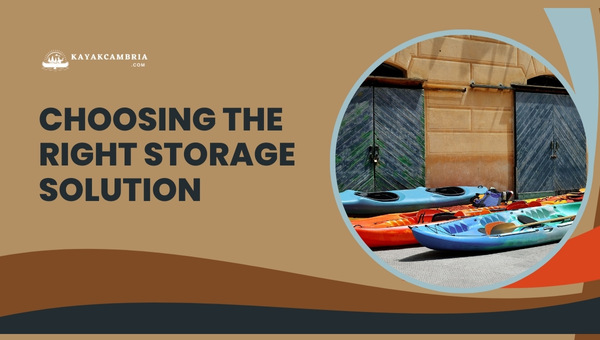
First, consider if you’re planning on storing your kayak for a short or long period. This decision will impact the type of storage solution that will suit your needs best.
- Short-term storage: If you’ll be using your kayak frequently during the season, consider convenient options like a wall-mounted rack, freestanding rack, or a sturdy kayak stand.
- Long-term storage: If you need to store your kayak for a longer period, protective and secure solutions like a customized kayak shed or a heavy-duty outdoor cover are more appropriate.
Next, take into account the available space you have outside for kayak storage. You may have a horizontal or vertical storage preference, depending on the space constraints:
- Horizontal storage: Keep your kayak flat and well-supported along its entire length, either on the ground or elevated. This method helps distribute the weight and prevents warping.
- Vertical storage: Store your kayak on the end, with the bow or stern on the ground and the opposite end supported above. This can save space but requires substantial wall reinforcement or a strong vertical storage rack.
Another crucial aspect is the climate in your area. The weather impacts your kayak storage needs, so pay attention to the most common conditions:
- Hot and sunny: Direct sunlight and excessive heat can cause your kayak to warp or fade. Make sure to store it in a shaded area, or use a UV-resistant cover to protect it from the sun.
- Rainy and/or humid: Constant moisture can lead to mold, mildew, or even rot on your kayak. Keep it stored in a well-ventilated, dry location and use a waterproof cover. Consider using a tarp, but ensure there’s proper airflow to prevent trapped moisture.
- Cold and snowy: Freezing temperatures can cause the kayak material to become brittle and crack. Storing your kayak off the ground, wrapped in a weather-resistant cover, can help prevent this issue, especially if snow and ice accumulate.
Lastly, don’t forget about security. Ensure your kayak is safely stored away from potential theft or vandalism:
- Use a robust locking system or cable lock to secure your kayak.
- Store your kayak in a well-lit, visible area or in a locked backyard/property for added security.
By considering these factors, you’ll surely find the best outdoor storage solution for your kayak, preserving its life while optimizing space and security.
Use Kayak Racks And Hangers To Store Kayaks Outside
One of the most effective methods is utilizing kayak racks and hangers when considering how to store kayaks outside. I’ve found that these storage solutions provide not only a practical way to conserve space but also protect your kayak from potential damage caused by environmental factors.
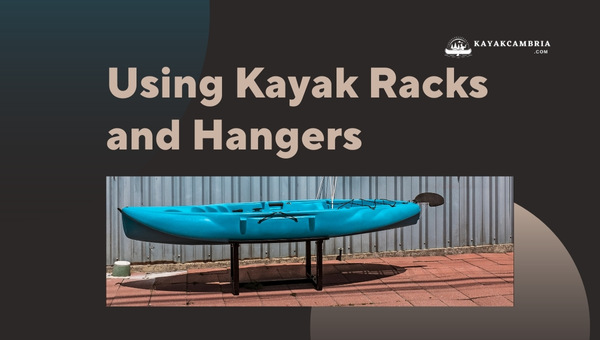
In this section, let’s explore the benefits of kayak racks and hangers, as well as some key features to look for when selecting the best option for your needs.
There are several advantages to using kayak racks and hangers for storing your kayak outside:
- Space Efficiency: Kayak racks and hangers are designed to maximize space, making it easier to store multiple kayaks without overcrowding your outdoor area. Depending on the model, you can securely store kayaks horizontally, vertically, or even suspended from the ceiling.
- Protection: Good-quality racks and hangers can help protect your kayak from scratches, warping, and UV damage caused by direct sunlight. They also prevent the kayak from sitting on the ground, which can lead to moisture buildup and potential mold growth.
- Accessibility: With a well-organized storage system, you’ll have easy access to your kayak when you’re ready to hit the water – no more digging through a mess of gear or struggling to lift a heavy kayak off the ground.
When choosing the right kayak rack or hanger, it’s important to consider the following factors:
- Material: Weather-resistant materials, such as powder-coated steel or heavy-duty plastic, are ideal for outdoor storage. These materials will not rust or corrode, ensuring long-term durability.
- Weight Capacity: Check the weight capacity of the rack or hanger to ensure it’s suitable for your kayak. Look for models that can easily support the weight of your specific kayak, and perhaps even more than one if you plan on expanding your kayak collection.
- Adjustability: Racks and hangers with adjustable features, like height or width adjustments, can accommodate various kayak sizes and styles, providing you with a versatile storage solution.
- Ease of Installation: Look for racks and hangers that are easy to install, with clear instructions and necessary hardware included.
Here are some popular types of kayak racks and hangers:
- Freestanding Racks: These are self-supporting and don’t require drilling into walls or posts. They can be easily repositioned and are suitable for both indoor and outdoor storage.
- Wall-Mounted Racks: As the name suggests, these racks are mounted to a wall or post, offering a space-saving solution perfect for smaller yards or patios.
- Ceiling-Mounted Hangers: Best for those with limited ground space or a high ceiling, these hangers suspend your kayak from above. Ensure that your ceiling can support the weight of your kayak before installation.
By selecting the right kayak rack or hanger, you’ll effectively store your kayak outside, protecting it from damage while also keeping it easily accessible for your next paddling adventure.
DIY Kayak Storage Options To Store A Kayak Outside
If you’re like me and enjoy the thrill of kayaking, you’ve probably thought about how to store kayaks outside on your own property. Outdoor storage can be an excellent option because it frees up garage space and makes it easy to access your kayak when you’re ready for your next adventure.
The key to successful outdoor kayak storage is to keep it secure and ensure that it’s well protected from the elements. In this section, I’ll discuss some effective and budget-friendly DIY kayak storage options.
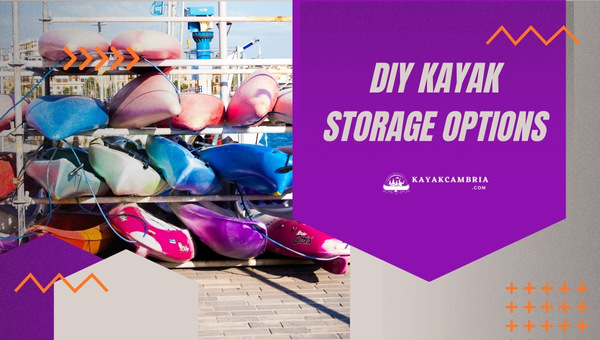
One popular option is creating a kayak storage rack. You can make one using a variety of materials, such as:
- PVC pipes
- Wood (preferably treated)
- Metal
Whichever material you choose, consider these guidelines to build a sturdy and reliable storage rack:
- Measure your kayak so you know the size of the rack you’ll need.
- Plan a design that provides enough space between kayaks to prevent scratches or damage.
- Ensure it’s tall enough to keep the kayak off the ground to avoid moisture-related issues.
Wall-mounted racks and hooks are another effective DIY storage solution. They’re perfect for exterior walls or even fence posts. Similar to storage racks, you can construct them from wood or metal. Here are some tips for wall-mounted storage:
- Use heavy-duty brackets, hooks, or hangers designed to carry the weight of your kayak.
- Position the mounting points to line up with your kayak’s strongest areas (usually the bulkheads).
- Install the hooks at a slight angle to prevent the kayak from accidentally slipping off.
If you’re not keen on constructing a rack or attaching hooks to your property, consider using a protective cover with a tie-down system. A simple tarp or custom-fitted cover can provide adequate protection from sun, rain, and dirt. To create a tie-down system, you’ll need:
- Anchor points (eye bolts, for example) mounted on the ground or a wall.
- Bungee cords or straps to secure the kayak.
By tying your kayak down, you’ll ensure it doesn’t get blown away during heavy winds or storms.
Lastly, always keep in mind the importance of protection from theft. A simple cable lock threaded through the kayak’s drain hole or security loop and connected to an immovable object can provide a good deterrent for would-be thieves.
As you can see, there’s no shortage of options when it comes to storing your kayak outside. With a little bit of creativity and some planning, you can create an efficient and cost-effective storage solution that keeps your watercraft both safe and easily accessible.
Storing Kayaks Outside On Sawhorses
Sawhorses are an excellent solution when exploring how to store kayaks outside. They’re not only affordable and straightforward, but these practical storage devices also elevate your kayak off the ground and enable proper water drainage.
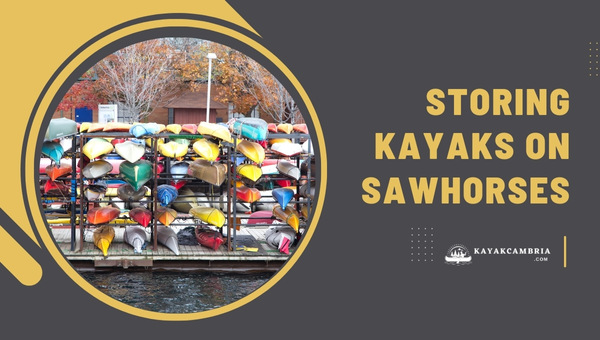
Sawhorses can be purchased or made with minimal effort using standard materials. When selecting the right one for your kayak storage, consider the following:
- The weight capacity of the sawhorse, as must accommodate your kayak.
- The dimensions of both the sawhorse and your kayak, to ensure a good fit.
- The materials used to create the sawhorse, with a preference for weather-resistant options suitable for outdoor storage.
It’s crucial to use adequate padding on the sawhorse’s top where the kayak contacts it, as it prevents any possible damage or deformation. Padding options include:
- Foam blocks
- Rubber pads
- Indoor/outdoor carpet
- Pipe insulation
Once you’ve got your padded sawhorses, you’ll need to position them properly for storage. Follow these steps for the best results:
- Identify a level outdoor surface for your kayak storage, preferably in a shaded area, to minimize exposure to the sun and other elements.
- Place the padded sawhorses around 4 to 7 feet apart, depending on the kayak’s length. Ensure they’re stable and secure.
- Carefully place the kayak on the sawhorses while keeping the cockpit facing down for better water drainage.
- Use bungee cords or straps to secure the kayak, preventing it from falling off during windy or stormy conditions. Don’t overtighten, as it might cause damage or deformation.
- Finally, consider using a fitted kayak cover or tarp to shield your kayak from the elements, preferably one that’s breathable and water-resistant.
Storing kayaks on sawhorses is a practical and efficient way to store kayaks outside. By choosing the right sawhorse, providing adequate padding, placing them on firm ground, and covering your kayak, you’ll keep your investment in good shape and ready for your next adventure.
Protecting Your Kayak From Theft
When figuring out how to store kayaks outside, it’s crucial to consider protecting your investment from potential theft. I’ll provide you with several tips and strategies you can implement to keep your kayak safe and secure when it’s not in use.
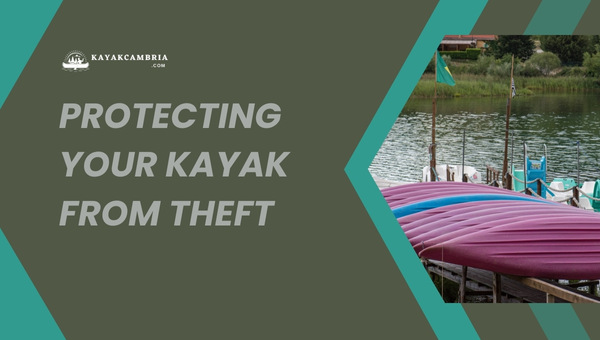
Location is key when it comes to storing your kayak outside. Make sure to choose a spot that’s visible from your house, so you can keep an eye on it. Avoid storing it near the street or other public areas, as doing so makes it more accessible to potential thieves.
Another essential aspect to consider is locking your kayak. There are several locking methods available, such as:
- Cable lock: Wrap a coated steel cable around your kayak and secure it to a fixed object, like a post or a rack. Ensure the cable is tight enough to deter thieves from removing it easily.
- Combination lock: Use a sturdy combination lock to secure the kayak’s grab handles to a solid anchor point. This way, it’s less likely to be stolen, as the thief would need to know the combination or have bolt cutters on hand.
- Lasso lock: Specifically designed for kayaks, these locks consist of two loops connected by a cable. Pass one loop through your kayak’s bow or stern and the other around a fixed anchor point, then lock the loops together.
To make your kayak less attractive to potential thieves, consider removing valuable accessories when you’re not using them. This can include items such as paddles, fishing gear, or GPS devices. Store these valuables indoors or in a locked storage container.
Another great method to protect your kayak is by using a cover. A high-quality cover not only protects your kayak from harsh weather conditions but also makes it harder for thieves to access it. Since the cover is an additional layer to remove, it can act as a deterrent for opportunistic thieves.
Lastly, mark your kayak for easy identification in case it’s ever stolen. Here are a few ways to do that:
- Write down your kayak’s serial number and keep it in a safe place.
- Use a permanent marker or tamper-resistant stickers to write your name and contact information on the kayak.
- Register your kayak with a national database, such as the Paddlesports North America registry.
Securing your outdoor kayak storage requires a combination of smart location choices, locking solutions, and additional security measures. By following these steps, you’ll have peace of mind knowing your kayak is safe while being stored outside.
Tips for Minimizing Sun Damage
Storing your kayak outside is often the most practical solution, but it’s crucial to keep sun damage in mind. In this section, I’ll share some helpful tips on how to store kayaks outside while minimizing sun damage.

Keep in mind that the sun’s UV rays can cause significant damage to your kayak over time. This can lead to fading colors, weakened materials, and reduced overall lifespan. To prevent these issues, follow these guidelines:
- Invest in a high-quality UV Protective Cover: This is your kayak’s first line of defense against UV damage. Make sure the cover is specifically designed for your kayak and offers a snug fit. These covers typically come with adjustable straps and a drawstring to help create the perfect fit.
- Store in a Shady Spot: Naturally, one of the best ways to protect your kayak from sun damage is to store it in a shady spot. If you don’t have a convenient shaded area, consider creating one using a canopy or shade sail.
- Rotate the Kayak Regularly: Ensure that your kayak isn’t always exposed to sunlight on the same side. By rotating the orientation every now and then, you can prevent excessive exposure to any particular area, minimizing the risk of sun damage.
- Utilize a Reflective Tarp: Another effective option for reducing sun exposure is to use a reflective tarp. Make sure to secure it so that it won’t blow away in strong winds.
- Regular Maintenance and Care: Beyond protecting your kayak from the sun, it’s essential to maintain its overall condition. Clean it thoroughly after each use, especially if you’ve been in saltwater or muddy areas. Additionally, inspect the kayak regularly for signs of wear or damage.
When you’re figuring out how to store kayaks outside while avoiding sun damage, consider investing in a quality UV cover, storing your kayak in a shady spot, rotating its orientation, using a reflective tarp, and maintaining it properly. By following these tips, you can enjoy your time on the water without worrying about the consequences of sun exposure.
Covering Your Kayak
As a seasoned kayaker, I understand the importance of protecting my kayak from the elements to keep it in top condition. In this section, I’ll delve into the various methods and materials you can use to ensure your kayak stays protected outdoors.
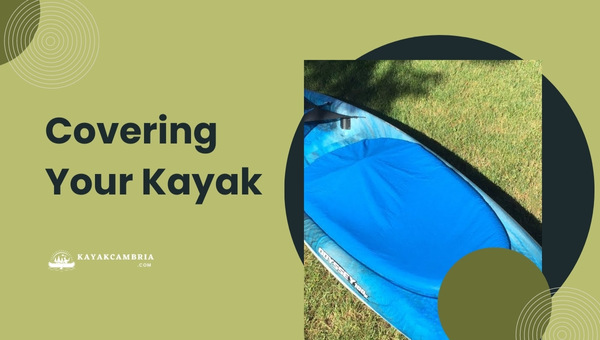
The first step in covering your kayak is choosing the right material. There are several options available, each with its own advantages:
- Polyethylene tarp: This type of tarp is affordable and easy to find. Its lightweight nature makes it a popular choice. However, poly tarps can be less durable, and you may need to replace them more frequently.
- Canvas tarp: Canvas tarps are made from natural fibers, making them more breathable and eco-friendly. They provide excellent protection but may be slightly more expensive.
- Vinyl tarp: Vinyl tarps are both durable and waterproof. While they can be on the pricier side, they’re a solid investment for long-term kayak storage.
Once you’ve selected your tarp material, it’s crucial to properly secure your kayak. Here’s a step-by-step guide on how to cover your kayak:
- Clean and dry your kayak: Before storing your kayak outside, ensure it’s clean and dry to prevent mold or mildew buildup.
- Place the kayak on a secure storage system: Using a storage rack or a set of sawhorses can elevate the kayak and protect it from pests or water damage.
- Cover the kayak with the chosen tarp: Drape the tarp over the entire kayak, making sure all parts are covered.
- Secure the tarp: Use bungee cords, straps, or rope to tightly secure the tarp around the kayak, preventing it from blowing away or letting moisture get inside.
Additionally, make sure to periodically check on your kayak during storage, especially after severe weather events. This will ensure your cover remains securely in place and that your kayak stays protected.
Learning how to store kayaks outside requires proper covering to avoid damage from the elements. By choosing the right material for your tarp and following the proper steps to secure it, you’ll prolong the life of your kayak and keep it ready for your next adventure.
Final Thoughts On How To Store A Kayak Outside
It’s crucial to know how to store kayaks outside properly to maintain their durability and longevity. In this article, I’ve explored a variety of methods to ensure your kayak remains in top condition, even when stored outdoors. To recap, remember these key takeaways:
- Choose a suitable location: Pick a spot that offers protection from direct sunlight, strong winds, and rain.
- Use a proper storage system: Invest in a high-quality kayak rack, hoist, or storage shed to keep your kayak safe and secure.
- Protect from the elements: Utilize a weatherproof cover and consider using a tarp to shield your kayak from UV rays, rainfall, and debris.
- Maintain a clean kayak: Clean and dry your kayak thoroughly before storing it outside to prevent mold and mildew growth.
- Keep it secure: Prevent theft by locking your kayak to an immovable object with a cable or chain lock.
By incorporating these tips on how to store kayaks outside, you’ll not only protect your investment but also ensure your kayak remains ready for your next outing. Don’t underestimate the importance of proper storage techniques—these can save you time, money, and the hassle of dealing with unnecessary repairs or replacements.

